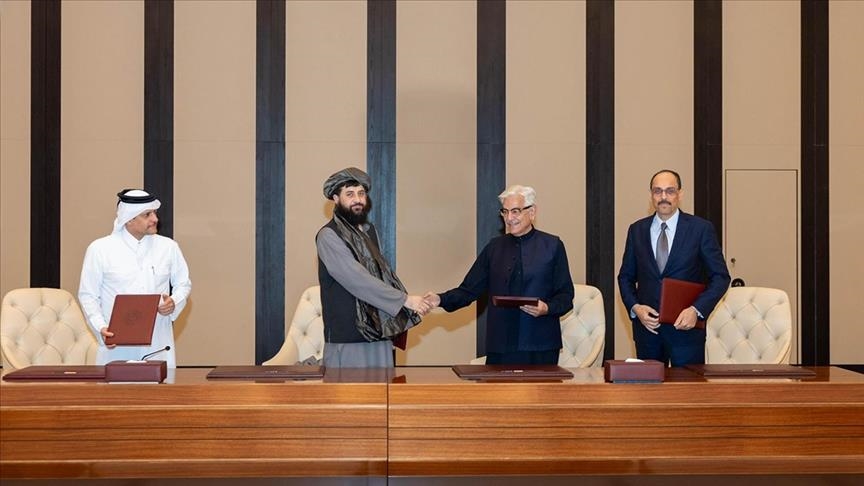
- An immediate ceasefire agreement was made between Pakistan and Afghanistan, under which neither country will carry out any hostile actions against the other.
- Pakistan and Afghanistan have agreed to establish systems to monitor and confirm that the ceasefire is being followed through the joint technical committee, and with continued diplomatic talks.
- India has reaffirmed support for Afghanistan’s sovereignty, territorial integrity, and independence.
The relationship between Pakistan and Afghanistan has historically been complex, with distrust and armed clashes. Despite cultural and economic links, the two nations have always faced tensions over border issues. The recent border clashes along the Durand Line highlight the long-standing historical disputes between the two countries. Pashtun identity and cross-border militancy continued to strain the relations.
The Durand line was established during British colonial rule and remains a point of dispute, as Afghanistan officially does not recognise it. These historical disputes have made diplomatic efforts challenging and have fueled violence along the border.
Recent Escalation
Pakistan has accused that Afghan territory has been used as a haven for militant groups such as Tehrik-e-Taliban Pakistan, and alleged that militants used Afghan soil to launch the attacks in Pakistan. Pakistan claims that more than 200 fighters on the Afghan side were killed, and many militant training camps were destroyed.
The escalation occurred in several phases. Pakistan launched airstrikes in Afghanistan targeting the TTP camps, and the Afghan Taliban stated that the strikes killed civilians. In response, the Taliban launched attacks on Pakistani territory. Many militants tried to enter Pakistan, and Pakistani forces conducted operations to stop them and resulting in the deaths of numerous militants.
A suicide bombing in Mir Ali killed and injured many Pakistani soldiers. The attack was claimed by the Hafiz Gul Bahadur group, which operates from Afghan territory. This attack was marked as one of the deadliest in the recent conflict. Pakistan faces triple challenges: militancy, ethnic discontent and economic strain. The violence led to public outrage in Afghanistan, protests and boycotts of Pakistani goods. Hundreds of people were killed and injured, and civilians were caught in the crossfire. Trade through border crossings such as Torkham and Chaman was disrupted.
Ceasefire and Doha Talks
Initially, both countries agreed to a temporary 48-hour ceasefire to pave the way for negotiations. This ceasefire coincided with the Doha talks, signalling both sides’ commitment to diplomatic solutions.
The Qatari Foreign Minister said that the ceasefire agreement was reached through negotiations mediated by Qatar and Turkey. Afghan government spokesperson Zabihullah Mujahid stated that Kabul’s delegation, led by Defence Minister Mullah Muhammad Yaqoob, arrived in Doha as promised. Pakistan’s Foreign Office confirmed that Defence Minister Khawaja Muhammad Asif led discussions with Afghan Taliban representatives, focusing on immediate measures to end the cross-border terrorism.
Key Elements of the Agreement
The key provisions of the Pakistan-Afghanistan agreement are an immediate ceasefire, so that neither country will have any hostile action against the other. The two nations have agreed to put in place mechanisms to monitor and verify compliance with the ceasefire by a joint technical committee and continuous diplomatic negotiations. Follow-up sessions have been organised to settle outstanding matters, with Pakistani authorities stating the next one will be held in Istanbul on 25th October to finalise implementation details.
Pakistan has asked for assurance that Afghan soil will not be utilised by extremist outfits to stage attacks on Pakistan, while Afghanistan has asked Pakistan to end airstrikes and keep out of its affairs. Aside from security issues, both countries aspire to enhance general diplomatic relations, which have been tense because of political conflicts and economic sanctions. They also want to advance general regional stability and enhance counter-terrorism activities throughout South Asia.
India’s Position
India has maintained a balanced stance regarding the recent clashes, emphasising regional security and diplomatic engagement. India has consistently expressed support for Afghanistan’s sovereignty and announced plans to reopen its embassy in Kabul. The Afghan Foreign Minister’s visits to New Delhi took place amid the border conflict.
India’s External Affairs Minister, S. Jaishankar, reaffirmed support for Afghanistan’s sovereignty, territorial integrity, and independence, and emphasised India’s intention to expand collaboration in trade, humanitarian aid, and development projects. While India cannot directly resolve tensions between Pakistan and Afghanistan, diplomatic engagement adds a constructive angle to regional stability if commitments are maintained.
International Support
The international community has closely monitored the Doha talks. The United Nations and regional organisations have called for sustained engagement and have emphasised humanitarian considerations, particularly for civilians affected by the border conflicts. Qatar, Saudi Arabia, and Turkey played key roles in mediating the ceasefire and encouraged both countries to maintain peace. Major powers, including the US, China, and the European Union, have expressed support for maintaining peace along the border.
The peace talks in Doha aim to reduce long-standing tensions between the two countries. While significant challenges remain, the temporary ceasefire, backed by international support, offers hope for a constructive resolution. If both countries adhere to the agreements, cross-border attacks could decrease. The key takeaway from the Doha talks is cautiously optimistic: diplomacy has temporarily silenced the guns.
Anshu Mishra holds a bachelor’s degree in History from Kolkata University and is currently preparing for the UPSC Civil Services Examination. Her interests include geopolitics, climate change, and national security. Views expressed are the author’s own.
